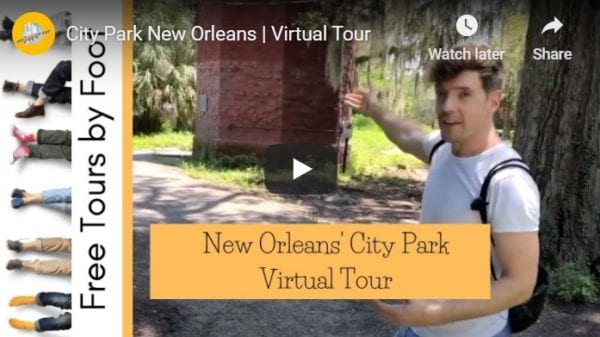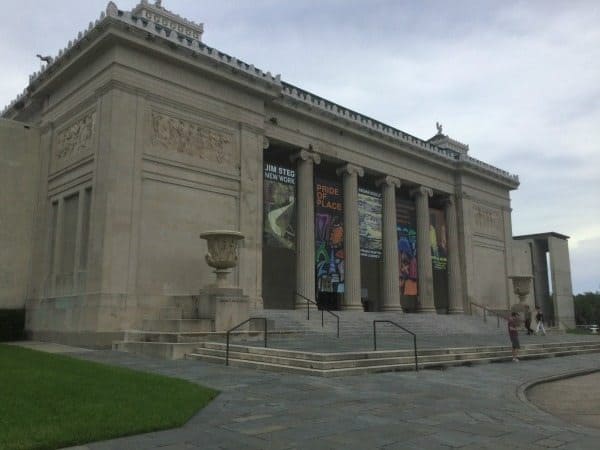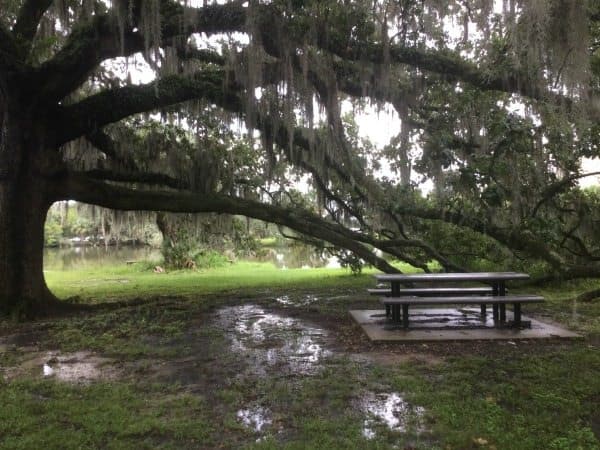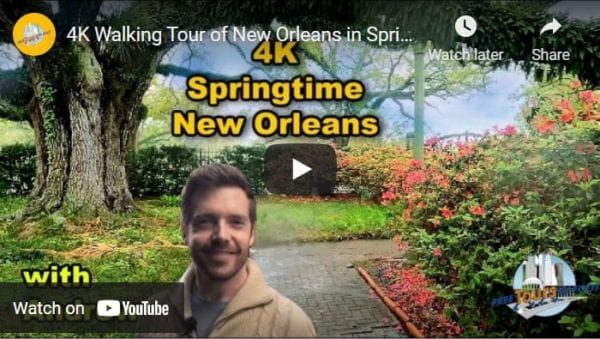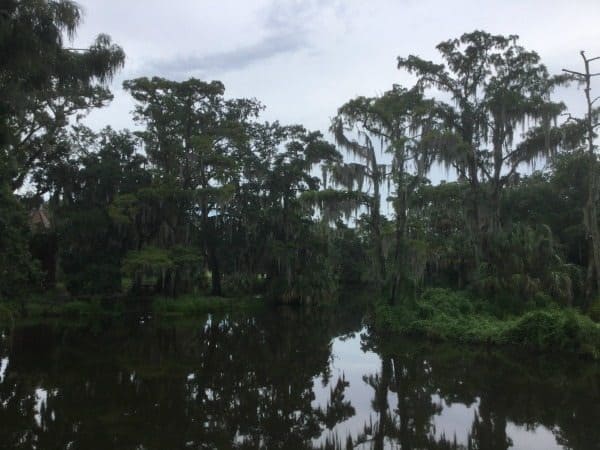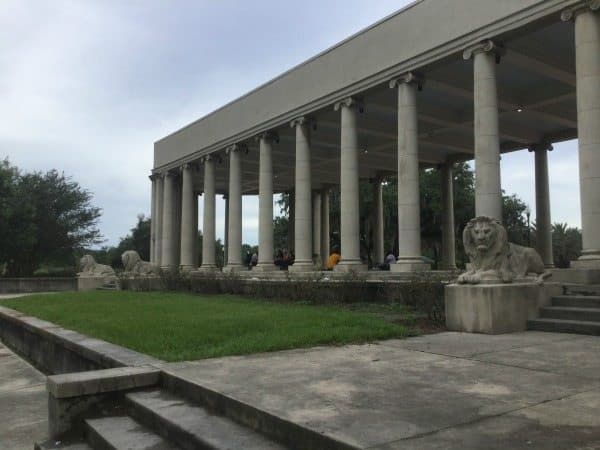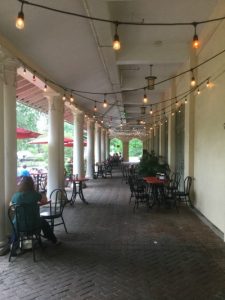This post is about all the things you can do in City Park, including enjoying nature, see great art, grab a bite and even see alligators.
- Overview of City Park
- Map
- Things to Do and See
- Where to See Alligators
- How to Find Cafe du Monde
- Free Tours by Foot
OVERVIEW
City Park has been a public space for New Orleans residents and visitors since 1854, when the land, formerly belonging to the Allard Plantation, was given to the city.
Most of its better-known attractions cluster near the southern corner of the rectangle – the part closest to the French Quarter.
The tour focuses on that portion, with some notes on further-flung sites added at the end.
The park preserves a sense of south Louisiana’s natural state, conveniently located in the middle of the city.
Natural highlights include Bayou Metairie, which captures the ambiance of local wetlands; the Botanical Gardens, which feature a wide variety of regional plants and garden styles; and the Couturie Forest, a nature preserve.
Louisiana’s distinctive greenery is everywhere – huge Southern live oaks with their drooping Spanish moss, bald cypress trees with their unusual prominent roots we call “knees,” and fan-shaped saw palmetto.
Birders love the park for the variety of waterfowl and other rarely seen birds it attracts.
Many parts of the park include identifying placards to help you understand what you’re seeing, in terms of both animal (including alligators) and plant life.
Art is also heavily featured in the park, with the city’s largest art museum (the New Orleans Museum of Art), the free Besthoff Sculpture Garden, and an assortment of 1930s sculptures and statues added by the WPA.
The Museum and the satellite Cafe Du Monde located beside it both host live music on some occasions.
Cafe Du Monde also adds a dining dimension to the park, as do restaurants located inside the museum and amusement park.
Other forms of entertainment, like a theme park for kids, a miniature train ride around the park, and an annual December lights display can add to the fun.
First, we recommend using this Google Map link for directions to City Park from anywhere.
From in or around the French Quarter, it’s easy to reach City Park by car, bike or public transit.
Public transit along Esplanade is also available by way of the #91 or Jackson/Esplanade bus, which includes stops in the Garden District, business district, and French Quarter.
Taking a streetcar is also an option – the Canal Streetcar (City Park/Museum), which passes through the main hub of French Quarter hotels, makes its last stop at the gate to City Park.
Be sure to read our post about riding the New Orleans Streetcars.
MAP OF CITY PARK
This is an interactive map. Just click on it to scroll around.
The park itself provides maps both of suggested routes and of the park itself.
THINGS TO SEE AND DO
This section will provide a list of attractions you can visit in New Orleans City Park.
If you're looking to explore the area on your own, you might want to consider the City Park Exploration Game. This game will task you with finding multiple sites in the park.
(Hint: You can use our guide for help!)
Where to Start
When you arrive, you’ll be just outside the park at the southernmost corner of the park.
Opposite the street from the park is Bayou St. John, a natural waterway that lets into Lake Pontchartrain, with beautiful historic homes along its edges.
Bayou St. John provides an alternate bike route – the road along the waterway connects with the Lafitte Greenway, a biking trail that leads directly to the French Quarter.
At the entrance to the park, you’ll see a long, divided drive with the New Orleans Museum of Art at the end. We begin along this drive.
1. Big Lake
Immediately at the start of the drive, a path diverges to the right, which circles Big Lake.
If you want to, you can bike or stroll around the lake and rejoin the drive on the other side without missing any of the subsequent items on the tour.
Going counterclockwise around the lake, you’ll soon encounter the Singing Oak, the first of many impressive southern live oak trees you’ll see – this one distinguished by its collection of wind chimes, including a massive fourteen-foot specimen.
Whenever the wind is blowing, you can hear the Singing Oak around much of the lake.
Beyond the Singing Oak, you’ll find Wheel Fun Rentals, which rents a variety of boats and bikes for exploring the park. Finally, the loop returns to the drive where we first started.
Somewhere along the way, you’re likely to encounter your first ducks, geese, and ibises – maybe a pelican, stork, or egret if you’re lucky. For guidance on the park’s avian life, read about the City Park Birding Corridor.
2. New Orleans Museum of Art (NOMA)
At the end of the drive is NOMA, the city’s largest and oldest art museum – opened in 1911 as the Delgado Museum. Besides a variety of temporary exhibitions and events, the permanent collection is notable for American, African, French and Japanese works.
The museum is open every day but Monday (hours vary daily, see website above). Admission is $12 for adults, with discounts for seniors, active-duty military, students, and children.
NOMA offers free admission to Louisiana residents every Wednesday – as well as in the month of August if the temperature is above 95F.
Visit NOMA’s website and check out their events calendar for upcoming programming, including tours, talks, film screenings, yoga classes, and more.
3. Roosevelt Mall and Tad Gormley Stadium
Continuing counterclockwise around the circle that encloses the New Orleans Museum of Art, you’ll reach a bridge, directly behind the museum (the second turn off the circle). Cross the bridge and you’ll be on Roosevelt Mall.
The tour will continue along Victory Avenue (to the left, past the fountain), but Roosevelt Mall provides an optional divergence for those inclined to cover more distance.
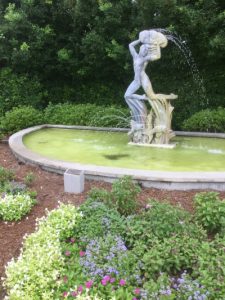
After a short distance, Roosevelt Mall divides into a wide boulevard. This area includes a great concentration of impressive southern live oaks.
Scenic drives in Louisiana – either in cities or, historically, leading from the river road to a plantation – tend to be lined with live oaks.
These trees are indigenous to the Gulf South and well-suited to damp soil and hurricane winds, although extreme conditions can still harm them, as in the case of Hurricane Katrina, which destroyed 2000 live oaks in City Park.
Their centuries-long lifespan and flexible wood lead to branches that brush the ground. The gray Spanish moss that hangs from their branches is, despite its name, not a parasitic moss but a harmless epiphyte – a plant in the family of bromeliads, which lives on moisture in the air and on the surrounding soil.
Air quality near heavily trafficked roads prevents its growth – hence its absence on more urban oak corridors like Esplanade Avenue.
Live oaks also tend to feature a plant called resurrection fern growing along their branches – green or brown, depending on recent weather, and able to dry out and then quickly rehydrate when exposed to rainwater, such that it appears to die and be reborn. Like Spanish moss, it does no harm to the trees.
Roosevelt Mall is named after President Franklin Delano Roosevelt, whose Works Progress Administration (WPA) is responsible for much of the park’s art and infrastructure, often recognizable by the era’s Art Deco style.
The park provides a guide to WPA-era contributions to the park – primarily detailing bridges at the time of writing, with the announced plan of adding other elements. From the foot of Roosevelt Mall, the most visible WPA-era structure is the fountain on the left side of the Mall.
At the end of Roosevelt Mall on the left is Tad Gormley Stadium, the largest of the park’s WPA-era creations. Notable moments in the stadium’s history include hosting a Beatles concert in 1964 (tickets were $5) and the Olympic track and field tryouts in 1992.
Today, it mainly hosts university and high school events and is the starting point for the annual Crescent City Classic marathon. At the time of writing, City Splash Water Park is projected for construction on the opposite side of Roosevelt Mall.
From the foot of Roosevelt Mall, turn left onto Victory Avenue, with the sculpture garden on your left and shortly passing the Pavilion of the Two Sisters on your right. Continue until you reach the Botanical Garden on your right.
4. New Orleans Botanical Garden
This 12-acre garden features a variety of native and non-native plants. Admission is $5 (discounts for children and free for Louisiana residents on Wednesdays); the garden is open 10 am-5 pm daily.
One portion centers around sculptures by Enrique Alferez, the Mexican sculptor responsible for the design of most of the park’s WPA structures.
Another area features an enormous train set, simulating the city’s once-expansive train network and the small towns and neighborhoods that bordered its tracks early in the 19th century (the model trains run on Saturdays and Sundays).
A greenhouse of rainforest plants and living fossils (prehistoric plants), a lily pond, and a small Japanese garden are among the other highlights.
The garden hosts weekly Thursday evening concerts beginning at 6 pm with a $10 admission. Consult the garden’s website for other events and to learn what plants are in bloom at the time of your visit.
5. Storyland and Carousel Gardens Amusement Park
Storyland is a children’s park of twenty enormous playground sculptures based on classic fairy tales. Carousel Gardens is an amusement park with seventeen rides, including a small Ferris wheel and roller coaster, plus a ren
owned wooden carousel listed on the National Register of Historic Places.
The small train that circulates through this portion of the park also begins from Carousel Gardens – for $4/person, the train takes you through the trees along Bayou Metairie, by the Sculpture Garden, and back to the starting place.
The train runs every day but Monday and can be reached through Storyland on weekdays.
Storyland is open daily from 10 am - 5 pm, while Carousel Gardens only opens Saturday and Sunday from 11am-6pm.
The admission of $4 (for visitors over three feet tall) includes both areas, with rides paid for individually. Another option is to pay $18 per person for unlimited rides.
Carousel Gardens is accessible either from inside Storyland or through its own separate gate, further down Victory Avenue.
From Storyland, look across Victory Avenue to find a small garden area, across the street from the Botanical Garden, and beyond it the Great Lawn.
A walk across the Great Lawn will bring you by City Putt, a miniature golf course, and to the Peristyle, a covered pavilion bordered with columns.
To find even more family-friendly activities, read our post on things to do with kids in New Orleans.
6. The Peristyle and Bayou Metairie
This 1907 pavilion is a popular venue for picnics or more formal events and looks out over Bayou Metairie – one of the best wetland views in the city.
Bayou Metairie, like Bayou St. John just outside the park, is a natural waterway – a cut off former portion of a river (in this case, the Mississippi). The banks of bayous provide naturally high elevation in south Louisiana’s low-lying terrain, which has led to them often being population centers in Louisiana’s history, both before and after European colonization.
Once much longer, Bayou Metairie has mostly been filled as the city expanded, but the Metairie Ridge greatly influenced the layout of the city – including eventually becoming the home of Metairie Cemetery, as the high ground is desirable for in-ground burial.
While the greenery along this surviving part of the bayou is cultivated, it nonetheless gives a realistic sense of the landscape of Louisiana, including live oaks, bald cypress (the state tree, so named for the fact that unlike most cypress it loses its leaves in the fall), and palmetto.
The large, durable leaves of the palmetto were key building material for the Native Americans of the region, who built dome-shaped homes from leaves and mud, moving uphill and down as floodwaters rose and receded.
Fishing is permitted in City Park’s waterways with a Louisiana fishing license, with a catch and release policy encouraged.
Either side of Bayou Metairie can make for a beautiful walk. In December of each year, the bayou (as well as the Botanical Garden and the amusement park) is key to the park’s lights display; some elements are visible all year long.
The bank of the bayou opposite the Peristyle offers a shaded walk through a grove of particularly ancient live oak trees.
The Old Grove, as the area is known, includes the oldest live oak in the park, the McDonogh Oak, aged approximately 800 years (you’ll know it by the plaque and the crutches holding up many of its branches).
To the left from the Peristyle along Bayou Metairie, you’ll pass a small playground and then arrive at Morning Call Coffee Stand.
7. Morning Call
Open 24 hours a day, Morning Call is one of the New Orleans local’s options for the classic coffee and beignet combo – a craving that strikes in the small hours of the morning surprisingly often.
Jambalaya, muffuletta sandwiches, and other classic New Orleans food, along with a signature mango freeze, round out the menu. Morning Call intermittently hosts live music as well.
Across the street from Morning Call, you’ll find one of the entrances to the Besthoff Sculpture Garden.
8. Besthoff Sculpture Garden
The Sydney and Walda Besthoff Sculpture Garden, established in 2003, has the unusual distinction of being planned around existing greenery – the mature pines, oaks, and magnolias that grow throughout City Park.
This five-acre sculpture garden features 64 pieces of art arranged around an arm of Bayou Metairie.
The park is open from 10am-6pm weekdays and 10am-5pm weekends and is free to enter. A digital guide and audio tour is available for free as well.
Exit the sculpture garden via the entrance by the pine grove, facing toward NOMA. Take a few steps to your right to find a large live oak tree set back slightly from the road. This is the Dueling Oak.
9. The Dueling Oak
In the 19th century, the shores of Bayou Metairie were a destination for all sorts of illicit activities, including the fighting of duels, a practice whose legal ban was actively enforced by 1855.
This tree and its former companion, lost in a 1949 hurricane, inherited the honor of being the locals’ preferred dueling site from St. Anthony’s Garden, the now-peaceful green space behind St. Louis Cathedral in the French Quarter.
Legend is the main source for stories about dueling at this site, and it does not disappoint – fights are alleged to have started over the honor of anything from one’s mistress to the Mississippi River (allegedly insulted by a European naturalist, who suffered at sword point for preferring the Rhine).
The surviving oak’s estimated age is around 300 years. The ground beneath its branches was also originally the burial site of Louis Allard, former owner of the plantation that became City Park.
This is the final stop on the tour. From here, you can easily return to the streetcar or bus route by walking along either the divided drive that first brought us into the park (to your left) or else the edge of Bayou Metairie (to your right).
Nature
Two adjacent nature preserves - Scout Island and Couturie Forest - make up much of the center of City Park. Car parking is available at the edge of either, and the trails within them are accessible to both bikers and hikers.
The two preserves are located side by side, and both are excellent sites for birding. If you’re interested in seeing an alligator, Scout Island is your best bet.
Quiet waterways like the ones surrounding Scout Island are an alligator’s preferred habitat, and with a sharp eye, you can spot one from a safe distance - they camouflage themselves as logs floating in the water.
Sporting
Most of City Park’s sports facilities are in the northern parts of the park. Several are free and open to the public, including a disc golf course, soccer fields, fishing piers for those who carry a state fishing license, and miles of bike trails in Scout Island, Couturie Forest, and the Wisner Tract.
Spaces that charge for access include the City Park/Pepsi Tennis Center, the Equest Farm horseback riding school, and Bayou Oaks Golf Course, which has two eighteen-hole courses and a driving range.
City Bark, a dog park, and the Grow Dat Youth Farm, a nonprofit educational farm largely operated by local high school students, make up the rest of the park’s north side.
Where to See Alligators in City Park
While the Southern third of City Park, closest to the French Quarter and the Canal Streetcar, is more densely developed and mostly walkable, the northern two-thirds of the park is more spread out and best explored with the help of a car or a bike - or a horse!
The lighter development on this side of the park makes it ideal for visitors looking for preserved natural areas or bike rides. It also makes this the side favored by the local wildlife.
Much of this land is also devoted to sports parks, from soccer to tennis to golf. You can find a map that includes this side of the park here.
Be sure to read our post comparing the many different swamp tours that operate just outside of the city for a more traditional and fun swamp boat experience where you are almost certain to see alligators.
10. City Putt
In addition to all of the other fun activities at City Park, they also have a mini-golf course known as City Putt. This location has 2 different courses with a total of 36 unique holes.
While one course focuses on the history of Louisiana, the other features iconic themes and locations from around New Orleans. You'll find this wonderful attraction right across the street from Carousel Gardens.
Tickets for the first course are $8 per person (13+) or $6 for kids (4-12). Play the second course for an additional $4 per person. Children 3 and under are free with a parental guardian.
City Putt is open from 10 am - 10 pm on Tuesday-Thursday and on Sundays. Hours are extended to 12 am on Friday and Saturday.
There is no food allowed on the courses, but refreshments will be available for purchase.
TIP: If you are looking for family-friendly activities, read our post on things to do with kids in New Orleans.





